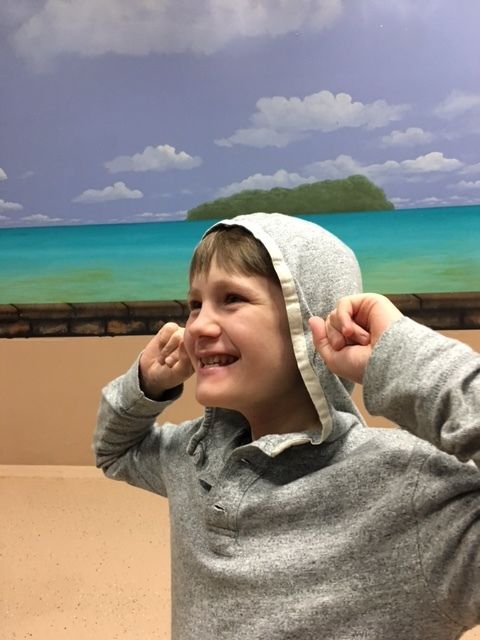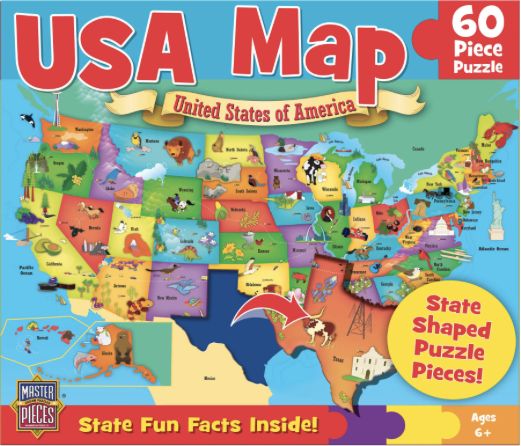
Blocking out the noise
My son with autism has some peculiar behaviors. He likes to take parts of toys or pieces of games and drop them on the floor, while he positions himself ear down to the ground, listening to the ping they make when they hit. In the olden days, a.k.a. when I freaked out about odd behaviors, I would have immediately interrupted these antics and stopped him. I secretly feared that if I didn’t he would be stuck like that forever, lost to autism.
But I don’t live in that place of fear anymore.
One day he had a fifty piece USA puzzle map made out of cardboard pieces, each piece carved in the shape of a state. He was doing one of his favorite activities, ear to the floor dropping each piece with intense focus. I got down on the floor and joined him in this activity. I didn’t get it. So I sat up and tried something different.

Puzzle Map
I took a piece and dropped it behind my back and asked him, “What state is this?”
He replied, “Illinois.”
What?!?! I didn’t believe it, how could he? Was it just luck?
I dropped another one behind my back, “What state is this?”
Without hesitation he replied, “Wyoming.”
I dropped another, and another, and another. He got them all.
It was quite remarkable and it changed the way I interact with him. Instead of fear and an insistence to stop him, I actually stood in awe of him. Being in awe of someone is a lot different than feeling fearful and confused. A child knows and feels the difference between those vibes.
And they will certainly be more open to connecting and relating with someone who reveres them versus disapproves of them. Plus their self-esteem will notch up. It’s a beautiful thing, understanding.
Behaviors serve two purposes. They provide information (if you are willing to be curious) and they are a form of communication. One of the most fascinating aspects of autism is the exquisite sensitivity that many individuals experience. Many of them see, hear, touch, smell and taste the world with such a heightened acuity, that the overwhelm can become so uncomfortable if not outright painful.
I say fascinating because there are amazing strengths and gifts tucked away in this extreme sensitivity. Our job as parents, caregivers and teachers is to understand their experience so we can modify their environment and then cultivate these differences, which are likely strengths in disguise. Otherwise, the trajectory is one of worsening frustration and further alienation between the autistic and those that care for them.
When a child with autism acts out, tantrums, head bangs, screams or gets aggressive, they are trying to tell you something. They may be uncomfortable, bored, feeling disrespected, ill, in pain or any number of awful feelings. If their verbal language is limited, or non-existent, than behaviors are all they have to get a point across. It is their only means for communicating.
Furthermore, there is one really, really important, actually critical thing for every parent, caregiver, and teacher to know. No matter what you see on the outside, it does not match what’s going on in the inside.
Outside appearance does not match inside intellect.
Intelligence is completely unrelated to the severity of a person’s autism. Severely autistic does not equal low intelligence. Throw that belief out right now, it’s false and it serves no one.
There is case after case after case to prove this. Many books have been written by autistic individuals that detail their senses, their experiences and their intellect. My favorite is “Ido in Autismland: Climbing Out of Autism’s Silent Prison” by Ido Kedar (S. Kedar).
Like Ido, many individuals are learning to communicate with letter boards or other modalities. They are finding their voice and what they have to say borders on the miraculous.

Using a letter board to spell
I sat with a mom recently, who discovered for the first time that her nineteen year-old son, non-verbal and “severely” autistic, was intellectually intact and understood everything. She had not known, until that moment, if her son could spell, let alone read. He was learning to use a letter board to spell out his thoughts and ideas.

Access to what’s inside using a letter board.
This mom waited nineteen years to discover her son was very much “in there”. It’s mind-blowing.
Look with curiosity. Don’t pretend to know what your child is experiencing or why he is behaving a certain way without really trying to understand his or her world.
My son often covers his ears in loud, crowded places. He has a pretty good tolerance for noise, but sometimes he is visibly uncomfortable. But he can also tell you from the other room, exactly what five musical notes were just struck on the piano, simultaneously. That’s a gift.
I am all for awareness, it is a start to the autism conversation. But if you want real progress, connection with your child, and a path towards a bright future, then understanding is the key.
